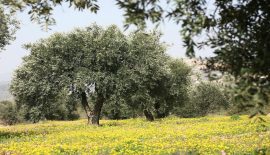Feasts of Autumn: Rosh Hashanah, Yom Kippur and Sukkot
Israel has three special celebration times in the autumn: New Year, the Day of Atonement (Yom Kippur) and the Feast of Tabernacles (Sukkot).
Rosh Hashanah (New Year) derives from the Biblical ‘day of the trumpet blast’ (Leviticus 23:24), which heralds the seventh month. So why New Year? Because then is the beginning of the Sabbatical and Jubilee years. In these two years, significant actions take place benefitting personal relationships within Jewish communities. The New Year also marks the beginning of the liturgical year (the festive calendar) beginning in spring with the month of Nisan, in which Passover falls.
New Year’s Day is a solemn day, the day of divine judgement, and the beginning of ten days of repentance, during which divine judgement can still be reversed. Yom Kippur is the day when judgment becomes final. However, Israel knows that God is not only righteous but also merciful and hears our prayer. The long-drawn shofar blast with which Yom Kippur is concluded sounds like the trumpet of redemption. That is why Yom Kippur is a holy holiday, even though it is a full day of fasting with prayers that are full of awareness of guilt and shortcomings.
Immediately after Yom Kippur, preparations begin for Sukkot, which begins four days later in the evening. A tabernacle is built as a meagre shelter for a week: for seven days, you leave the comforts of your home behind and sit in the tabernacle, with only a canopy over your head, through which you can see the sky. This recalls Israel’s journey through the desert because there man lived in utter dependence on God. When the apostle Paul speaks of the earthly tent (2 Corinthians 5), we are reminded of the tabernacle.
But Sukkot is not a sombre and subdued feast. On the contrary it is full of exuberant joy. There is a Biblical command for this feast (Deuteronomy 16:14-15). Like the other two pilgrimage festivals, Passover and Shavuot, Sukkot is also originally linked to the harvest. In Israel, this is the conclusion of the season of fruit and especially grape harvests. The winter season begins when the rains fall.
‘It is remarkable that the feasts of autumn are not reflected on the Christian calendar.’
It is remarkable that the feasts of autumn are not reflected on the Christian calendar. We celebrate Easter and Pentecost, which correspond to Passover and Shavuot. But Sukkot, the third major pilgrimage feast, seems to have disappeared from the church. Yet that is precisely the feast where, from the Jewish point of view, the gentile nations come into the picture. Zechariah 14 is read during Sukkot in the synagogue, where it says that the nations will go up from year to year to celebrate the Feast of Tabernacles in Jerusalem. A total of 70 bulls were sacrificed in the temple during the Feast (Numbers 29). Jewish tradition explains that this was for the 70 nations of the world (Genesis 10). So, Sukkot is (also) a feast for the nations.
After all, Jesus also celebrated the Feast of Tabernacles (John 7). With Sukkot, we see Jesus as the Hidden One (7:1-13), the Teacher (7:14-36), the Water of Life (7:37-53), the Light of the world (8:12-9:41) and as the Good Shepherd (10:1-21). The names Jesus bears here all refer to Israel’s journey through the desert. As Water and as Light, as Shepherd and as Teacher: this is how we see Jesus depicted during the celebration of the Feast of Tabernacles in Jerusalem.
‘The Book of Revelation is like a liturgy for the feasts of the autumn’
The Book of Revelation is like a liturgy for the feasts of the autumn, from the Day of the Trumpet (Revelation 1) to Sukkot, where the crowd, that no one can count, stands clothed in white before the Throne with palm branches in their hands (Revelation 7:9). Together with Israel (Revelation 7:1-8), the saved nations sing the praises of the God of Israel. We learn that with the Feast of Tabernacles. Are we ready for this in the church yet?






